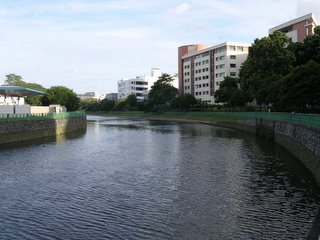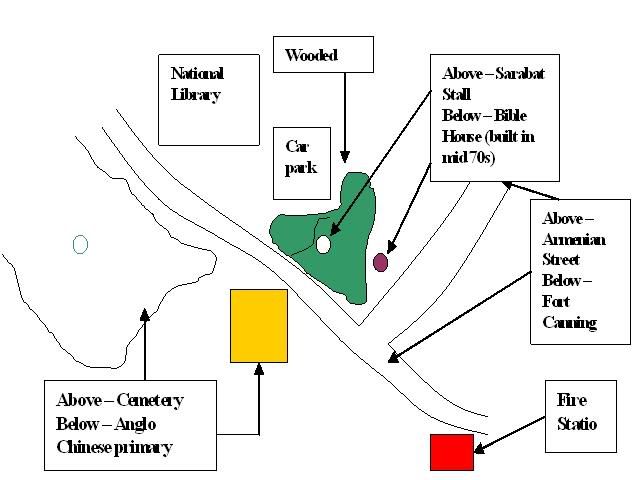
I read in the papers recently that the Ford Factory at Bukit Timah has been preserved as a national heritage site. Reading some of the blog articles about this place brought back memories of the 2 months of practical training I spent in Ford Factory as a university undergrad back in 1975.
 There was another student with me but I cannot remember his name as he was from another department. At that time they built mostly the Ford Cortina and Ford Escort models plus some vans for the local market.
There was another student with me but I cannot remember his name as he was from another department. At that time they built mostly the Ford Cortina and Ford Escort models plus some vans for the local market.
 The Ford Escort was popular with Mindef and the Police Force
The Ford Escort was popular with Mindef and the Police Force
Although I can still remember most of the manufacturing processes, being an industrial engineer and all, I do not intend to bore you with those details. Instead I would like to blog about some of the very friendly and interesting people I met during my 2 months there.
The first person I remember is a small-built Malay man by the name of Mohammed who worked as a quality control inspector in charge of final inspection. Every morning, he would randomly select one of the completed vehicles and do a final inspection. I remember riding with him to test-drive the new cars at the deserted Lorong Sesuai that led up the Bt Batok hill just behind the factory. Watching him test the brakes and do figure-8 turns was great fun.

 Lorong Sesuai today is part of the Bt Batok Nature Park
Lorong Sesuai today is part of the Bt Batok Nature ParkAnother interesting character I met was an elderly gentleman who worked in the final assembly line. He was a funny and friendly guy. He was in charge of assembling the wheels and tyres to the car. He told us that at its peak, the factory used to assemble about 20 cars a day. That meant that he had to assemble 100 wheels a day; 5 per vehicle, including the spare tyre. But by the 1970’s, the motor car assembly industry was on the decline, and they only did about 4 or 5 vehicles a day.
One day, he taught us how to assemble the rubber tyre and inner tube (I
 suppose tubeless tyres were not in use then) to the tyre rim. This was a manual process which required considerable strength. First the steel rim is mounted on a fixture. Next the rubber tyre with inner tube is positioned over the rim. Then comes the difficult part of assembling the tyre into the rim. Nowadays, this is done effortlessly with the help of a machine, like the one in the picture here, which you can see in any tyre shop. But back then, you have to manually connect a steel arm to the fixture and rotate it manually to force the edges of the tyre into the rim. Although it looked so simple when he was doing it, my friend and I had to struggle like mad to do it. Some of the younger workers who witnessed us struggling with this task laughed at us. They were probably telling themselves, “Just look at these 2 wimpy book worms from the university.”
suppose tubeless tyres were not in use then) to the tyre rim. This was a manual process which required considerable strength. First the steel rim is mounted on a fixture. Next the rubber tyre with inner tube is positioned over the rim. Then comes the difficult part of assembling the tyre into the rim. Nowadays, this is done effortlessly with the help of a machine, like the one in the picture here, which you can see in any tyre shop. But back then, you have to manually connect a steel arm to the fixture and rotate it manually to force the edges of the tyre into the rim. Although it looked so simple when he was doing it, my friend and I had to struggle like mad to do it. Some of the younger workers who witnessed us struggling with this task laughed at us. They were probably telling themselves, “Just look at these 2 wimpy book worms from the university.” Then this elderly worker told them; “Don’t laugh. If you think it is so easy, why don’t you come and give it a try?” So the young workers took up the challenge. And to our pleasant surprise, they too had a tough time. After that incident, we became friends.
The reason I remember this incident so clearly is that I often quoted it when I conducted Ergonomics lectures at the National Productivity Board’s Industrial Engineering courses, when touching on the topic of designing work for older workers. Contrary to popular belief, physical strength is not the most serious obstacle for older workers. Their biggest problem was information processing.
I remember an amusing incident involving my new friends. One day, the elderly worker observed that, because my face and hands were quite ruddy, I must be a lucky fellow. They jokingly asked me for some 4D numbers. So I showed them my matriculation card. My matriculation number was 1075, I can still recall. Suddenly they got very excited. Apparently, this number came out first prize in the 4D lottery just the week before. “Why didn’t you give us earlier?” they said. Then they took down practically every number they could find on me, from my NRIC number, to my birth date and even the serial number on my watch. Unfortunately, none of these numbers turned out to be 'lucky'.
One weekend towards the end of my attachment, they brought me fishing at the Kranji River mouth area. We went to one of the guys’ kampong home at the Bukit Panjang area where we dug for earthworms. We caught several tilapias that day, but they tasted so horrible that even my cat Mimi did not want to eat them. I borrowed my family’s car for that occasion and fetched the elderly worker home after our fishing trip. When we reached his home at Stirling Road, he asked me if I would like to come up for a cup of coffee. He wanted to introduce me to her daughter!!! (who apparently was still schooling) I shyly declined. But I wonder how my life would have turned out if I had accepted his invitation for that cup of coffee.











 Bible House Viewed from Canning Rise
Bible House Viewed from Canning Rise










